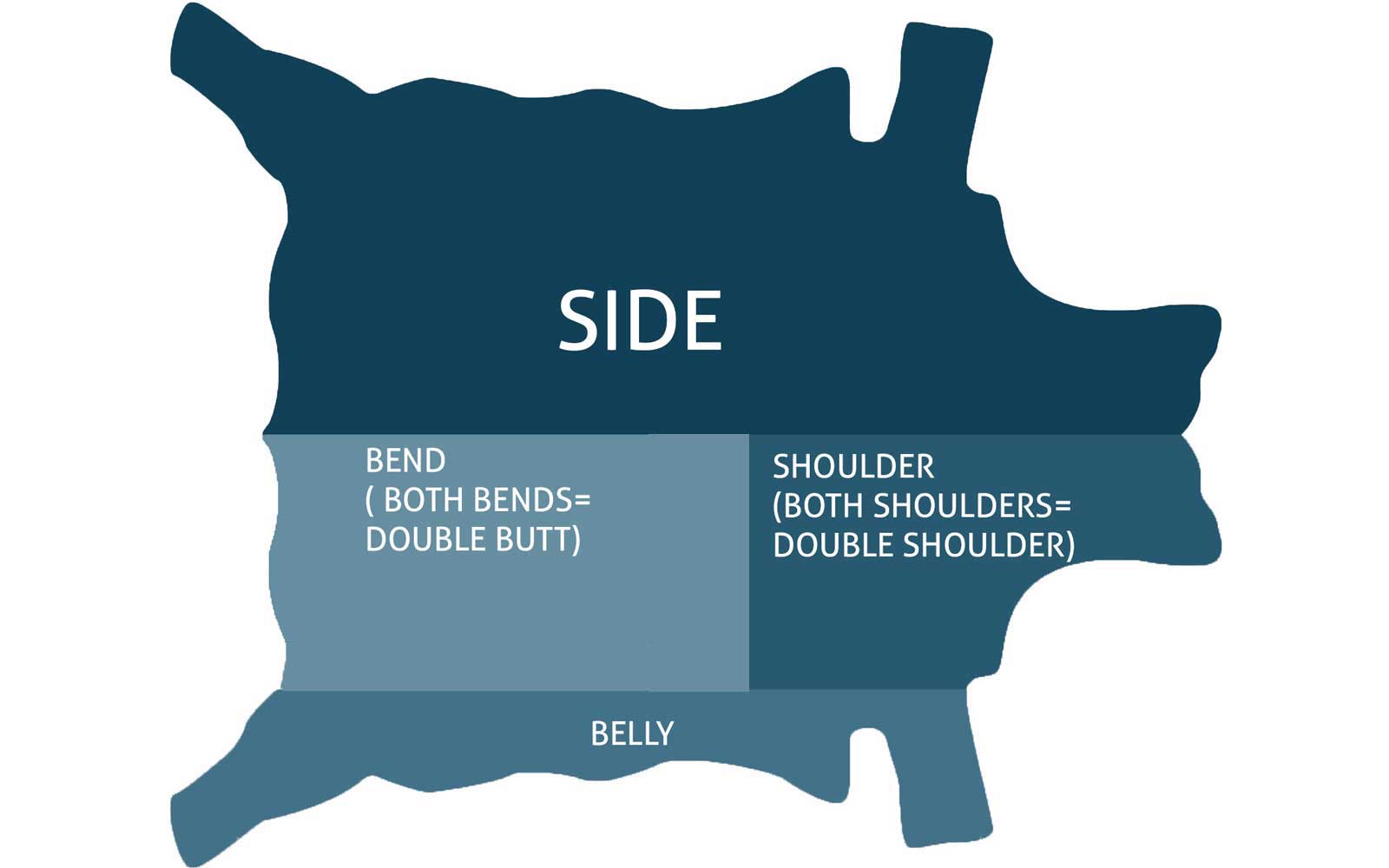
Leather Hide Parts
Posted on
Selecting the Right Leather Cut for Your Project
Choosing the right leather hide parts can make or break your project. Whether you're fashioning a sleek wallet, upholstering furniture, or creating bespoke accessories, understanding the different parts of a hide ensures your work is both durable and visually appealing. In this leather buying guide, we’ll break down five primary leather cuts—belly, shoulder, bend, side, and whole hide—so you can pick the perfect option for your next creation.
Why Leather Cuts Matter
Every part of a leather hide offers unique qualities. These differences impact how the leather performs, looks, and lasts. Here’s why it’s important:
-
Durability: Some cuts are stronger and more resistant to wear.
-
Flexibility: Certain sections are easier to bend and shape.
-
Appearance: The texture and grain vary across the hide.
- Cost: Using the right cut can save you money and reduce waste.
By matching the right leather cut to your project needs, you’ll not only improve the final result but also make the crafting process smoother.
Let’s explore each leather cut and its best uses.
Belly Leather: Affordable with Unique Character
The belly cut comes from the lower edge of the hide. It’s known for its flexibility and natural markings, which can add charm to your work.
Characteristics of Belly Leather:
-
Stretchy and flexible: Great for projects needing movement.
-
Uneven thickness: Adds a rustic, organic feel.
-
Budget-friendly: Perfect for those just starting out.
- Distinct markings: Each piece has its own personality.
Best Uses for Belly Leather:
- Wallets or coin pouches.
- Casual belts where stretch is acceptable.
- Decorative items that highlight natural imperfections.
- Practice pieces for beginners
Tip: Belly leather works best for smaller projects or items that don’t need a rigid structure.
Shoulder Leather: Versatile and Reliable
Shoulder leather is one of the most popular cuts, offering a balance of durability, flexibility, and aesthetics. It comes from the upper section near the animal's neck.
Characteristics of Shoulder Leather:
- Firm yet flexible: Suitable for a range of items.
- Natural grain: Adds a touch of elegance.
- Even thickness: Easier to work with for many projects.
- Good for both hand and machine stitching.
Best Uses for Shoulder Leather:
- Handles and straps.
- Medium-duty belts.
- Tool holders or cases.
- Purses, satchels, and everyday bags.
Tip: Shoulder leather may need regular conditioning to maintain flexibility, especially in dry climates.
Bend Leather: Durable and Consistent
The bend comes from the central back part of the hide. It’s highly favoured for its strength and consistency, making it the go-to for projects requiring durability.
Characteristics of Bend Leather:
- High durability: Long-lasting and resistant to wear.
- Uniform thickness: Ideal for precision work.
- Minimal stretch: Great for keeping shapes intact.
- Available as single or double bends: Double bends include both sides of the backbone
Best Uses for Bend Leather:
- High-quality, long-lasting belts.
- Footwear components like soles or straps.
- Saddles or tack for horses.
- Furniture parts that face heavy use.
Tip: Bend leather is the best choice for items where strength and structure are a priority.
Side Leather: All-in-One Variety
Side leather includes large sections of the hide, covering the belly, shoulder, and bend. It’s versatile and offers a mix of textures and thicknesses.
Characteristics of Side Leather:
- Varied textures: A single piece includes flexible and firm areas.
- Economical: Great for making multiple items at once.
- Large surface area: Suitable for bigger projects.
- Great for learning: Explore which sections work best for specific uses.
Best Uses for Side Leather:
- Mixed projects needing different leather parts.
- Garments or jackets requiring flexibility and strength in different spots.
- Learning pieces or experimental work.
- Matching accessory sets.
Tip: Plan your cutting layout carefully to maximise yield from side leather.
Whole Hide: Maximum Freedom
Whole hide is exactly what it sounds like—the entire leather hide in one piece. It offers full access to all cuts, making it a great choice for large-scale or high-volume projects.
Characteristics of Whole Hide:
- Complete hide: Includes all sections like belly, shoulder, bend, and more.
- Flexible usage: Suitable for nearly any type of project.
- Efficient for large projects: Great for cutting continuous pieces.
- Cost-effective for bulk production.
Best Uses for Whole Hide:
- Furniture upholstery.
- Vehicle interiors.
- Jackets and full-length garments.
- Production runs of smaller items like wallets or bags
Tip: Plan your cutting pattern in advance to make the most of the hide.
How to Choose the Right Leather Cut
To pick the ideal part of a leather hide for your project, consider these factors:
- Project Needs: Does your project require durability, flexibility, or an attractive grain?
- Budget: Bend leather is premium, while belly leather is more affordable.
- Aesthetics: Do you want uniformity or natural character?
- Project Size: Side or whole hide works well for larger items.
- Skill Level: Beginners might prefer cuts with consistent thickness, like shoulder or bend leather.
Making the Most of Your Leather
Choosing the right leather cut goes hand-in-hand with your crafting goals. When you understand the unique features of each section of the hide, every piece you create will reflect the care and thought you put into it.
Experimenting with different leather hide parts will not only improve your skills but also give you a better sense of how to match materials with your vision. Whether you’re working on a one-off design or mass production, the right leather cut and leather type can elevate your work and make it truly stand out.
So, take these insights and start planning your next masterpiece. With the right leather in hand, the possibilities are endless!
Leather Buying Guide
Contact
Contact Information
📞 Phone: 0412 127 327
📧 Email: admin@leathercircle.com
📍 Location: Epping, VIC 3076
🔒 Safe & Secure Checkout

Leave a comment: